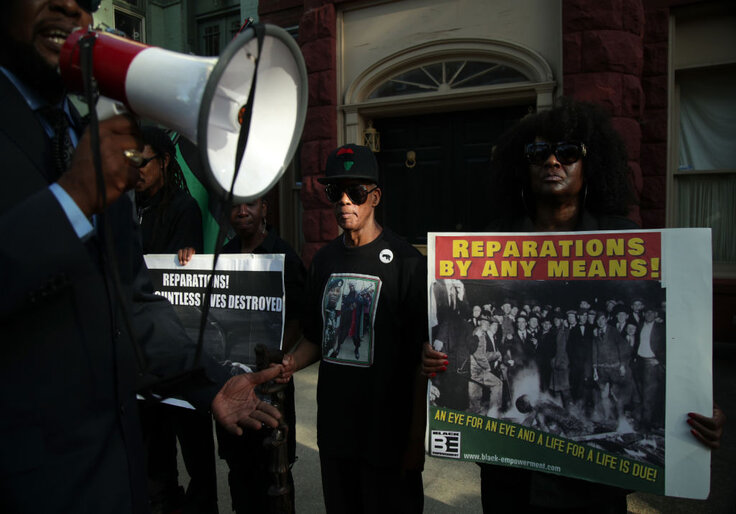Reparations for slavery are having a moment. Progressive Democrats made support for reparations a key part of their 2020 pitch, and nearly 200 cosponsored a House resolution to create a commission to study the idea. State and local governments have weighed whether and how to give their black residents remuneration for their ancestors' enslavement. California has organized a state commission. From Boston to St. Paul, cities are doing the same.
The return of reparations to the public debate has raised old questions. Should black Americans get reparations for slavery? If so, how much should be paid, and to whom? One question, though, has received too little attention: From whom will all that money—as much as $15 trillion, the amount of the black/white wealth gap—come?
As I argue in a recent Manhattan Institute report, that question poses a thornier problem for reparations advocates than they might like to admit. Many Americans—as many as 70 percent, by my estimates—are descended from immigrants who arrived to the United States after the Civil War. This includes many of the wealthiest, including recent immigrant billionaires and high-earning ethnic groups like Jewish Americans. Reparations would hold as responsible for slavery individuals who can claim limited or no benefit from it—a fact that will only become more challenging to the reparations project, and historical-injustice-based redistribution generally, as America further diversifies.
Such concerns matter in part because of the scale of reparations. Proponents routinely estimate that the amount necessary to pay for the harms of slavery runs into the trillions of dollars. Where does all of this money come from? Colleges can't pay for it: The total value of endowments tracked by the National Association of College and University Business Officers is just over $800 billion. Businesses can't pay for it, either. Total annual corporate profits are about $2.8 trillion, meaning that American business would be taxed out of existence before they could cover the full cost.
The only plausible source of reparations funding, then, is the U.S. government and, by extension, the U.S. taxpayer. But which taxpayers? After all, many Americans cannot trace their ancestry to slaveholders, or even to a time when slavery was legal. Why should those individuals pay for reparations?
The number of nonblack Americans who are the product of post-Civil War immigration is not small. Both of the great waves of immigration in U.S. history took place after 1865. The first, between the end of the war and 1924, added more than 30 million people to the United States—a substantial addition compared with a population of 38 million circa 1870. The second, inaugurated by the 1965 Hart-Celler Act, has added nearly 60 million more, including most of the nation's Asian and Hispanic residents. Not only these people, but also their descendants, make up an appreciable fraction of today's population.
How large a fraction? In the report, I attempt to answer this question by simulating how America's population would have grown if there had been no immigration from 1860 onwards. This exercise, though imprecise, nonetheless yields the estimate that absent post-war immigration, the nonblack population of the United States today would be about 88 million. That represents about 30 percent of the actual nonblack population (286 million) and slightly less than half of the non-Hispanic white population (197 million).
What this means is that there are almost certainly millions of Americans—not just Hispanic and Asian, but white as well—whose ancestors arrived after the end of slavery, and who therefore did not benefit, or at least benefited far less, from slavery. What is more, many of these Americans are among the wealthiest, and therefore those most likely to be taxed to pay for reparations. Among the top 50 American billionaires identified by Forbes, for example, seven are immigrants, and at least two more are the children of immigrants. Many of the remainder, it should be further noted, are Jewish, a population whose ancestors arrived almost entirely after the end of the Civil War.
Some might object that the nonblack descendants of more recent arrivals still benefited from the legacy of slavery, or from subsequent institutionalized discrimination against black people, e.g. Jim Crow. Be that as it may, those descendants did not benefit as much, and so it seems odd to tax them equally. The just-arrived immigrant from Vietnam cannot be held as responsible for slavery as the sixth-generation descendant of slaveholders, for example.
This observation gets at a deeper problem for reparations, and indeed for all redistributive policies predicated on correcting historical disadvantage. America is a rapidly diversifying country: By 2065, the Pew Research Center has projected, the American population will be majority first- or second-generation immigrants. As this population grows, arguments that depend on long-gone injustices lose their potency.
Indeed, this already appears to be happening. Last summer, the Supreme Court struck down race-based affirmative action in college admissions in the Students for Fair Admissions case. That ruling represented a victory for the conservative legal movement. But it also, as many commentators observed at the time, was a necessary product of demographic change. When affirmative action was first enshrined as a policy in the early 1960s, it meant depriving the very large white majority of a few seats to benefit the small, and obviously disadvantaged, black minority. Today, however, affirmative action means disadvantaging another minority—Asians—in a transfer of benefit that struck many as unfair. That change in valence would not have been possible without the dramatic growth of the Asian population, from about 0.5 percent of the population in 1960 to more than 6 percent today.
As reparations continues to take up oxygen in the public debate, then, the "who pays" problem can and should be a potent counterargument for opponents. Indeed, as America continues to diversify, it will only grow more so.
Charles Fain Lehman is a fellow at the Manhattan Institute, contributing editor of City Journal, and 2023-24 Robert Novak Journalism Fellow.
